Samsung QuickDrive WW6800 (WW80M645OPW) Review
Samsung QuickDrive WW6800 (WW80M645OPW) Review
Fast washing and low running costs – what more do you need from a washing machine?
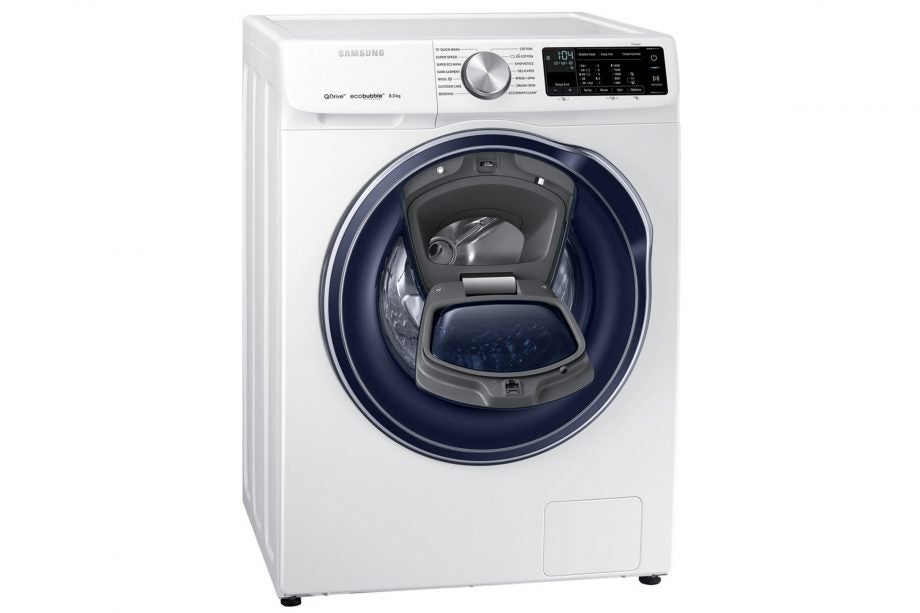
Verdict
Pros
- Excellent wash results
- Speedy washing
- Effective spin
- Brilliant AddWash door
- Low running costs
- Very, very quiet
Cons
- Variable finish time
- Two-rinse default
Key Specifications
- Review Price: £869.99
- 8kg load capacity
- A+++ -40% energy efficiency
- 1400 spin speed
- AddWash door
- QuickDrive Pulsator drum
- ecobubble technology
- Intertek Fabric Care approval
- 15min Quick wash
- Smart connected controls
- 5-year guarantee
What is the Samsung QuickDrive WW6800?
With an innovative contra-rotating drum paddle to speed up washes, ecobubble technology and an AddWash door, Samsung’s new QuickDrive machines are bristling with innovation and handy features. The 8kg WW6800 (WW80M645OPW) tested here is the entry-level model in the QuickDrive series.
Super-quick washes on all cycles, ridiculously frugal water and energy use, and great wash results all round make this Samsung a real contender. Top that with our favourite AddWash door, one of the first genuinely innovative washing apps we’ve seen, and super-quiet operation, and the WW6800 is an absolute best buy for the smaller family.
Related: Best washing machines 2019
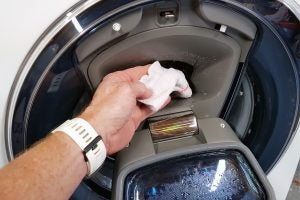
Samsung QuickDrive WW6800 – What is it like to use?
The WW6800 is the baby model in Samsung’s QuickDrive series, but you wouldn’t know it from the burgeoning features list. The genuine 8kg load capacity, 1400 spin speed, extremely low noise and incredible A+++ -40% energy efficiency are up there with most maker’s top-of-the-line models. The price is far from entry level, but Samsung pours on the features, tech and performance to more than justify the outlay.
Top of that billing is Samsung’s innovative QuickDrive drum. Its rear has a trio of paddles, the Pulsator, which rotates independently of the drum depending on where the programme is in its cycle. During the wash phase, the Pulsator rotates in the opposite direction to the drum, effectively tumbling your washing front to back as well as the normal tumble with the rotation of the drum.
The upshot is more effective mechanical washing that allows for much shorter wash times, hence the name QuickDrive.
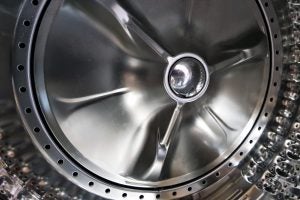
On spin, the Pulsator helps to distribute the load around the drum before switching into sync with the main motor for the full spin. With two motors and a mind-boggling twin coaxially mounted bearings, the QuickDrive drum is quite a feat of engineering.
You might think all that double-tumbling action might be a bit tough on your clothes, but the opposite is true. The QuickDrive system shortens wash time, which means your clothes are being thrown around far less than on a standard wash.
The upshot is that the WW6800 (and all of Samsung’s QuickDrive machines, in fact) are Gentle Fabric Care approved by the independent testing body, Intertek.
Thankfully, all that drum technology is automatic and doesn’t detract from what is a super-easy machine to use. The big rotary dial in the middle of the display chooses the main programme, with the display to its right showing wash time and icons for that programme’s standard features.
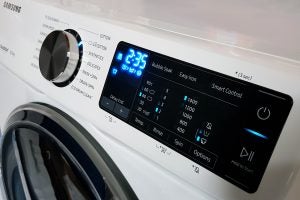
The options panel is delightfully straightforward. Three buttons cover temperature, number of rinses and maximum spin speed, each scrolling through five options with LED indicators. The default temperature and spin speed is a function of the programme chosen, while the number of rinses defaults to two. Those with sensitive skin might want to increase that to ensure the most thorough removal of any detergent residue.
A fourth button provides access to the options, Intensive wash, Pre-Wash and turning the sound off. The button-press beeps and end-jingle are inoffensive enough, but we could understand why you might want to turn them off if you’re regularly washing.
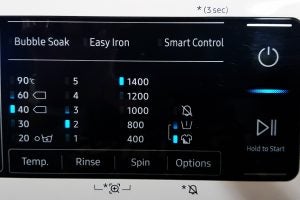
There are three further options buttons along the top of the panel. Samsung’s Bubble Soak uses an air-injected water and detergent mix to soak into your clothes for a deeper clean. Easy Iron reduces spin speed to lessen creasing. Plus, the Smart Control button sets up Wi-Fi for SmartThings app access (see What programmes does it have?). All of the buttons respond well to touch commands, and the crisp blue display is easy to read.
Samsung’s AddWash door makes a welcome addition here. For those inclined to drop a sock on the way to the washing machine, forget that dirty cycling gear in the sports bag, or remember just too late that item that is needed urgently, AddWash is a gift.
As long as the water temperature is below 50ºC, you can pause the cycle to throw in those errant garments through the pop-open mini AddWash door at any point in the cycle. Ideally, that will still be while the machine is in its wash phase, but even a late rinse and spin may be preferable to waiting for the next load.
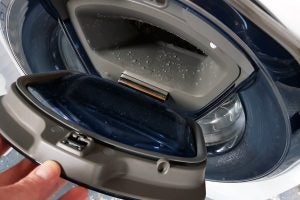
The big door opens to reveal a slightly smaller opening than you might imagine, but we still managed to get the test duvet in there without using a foot. The 8kg load capacity is compact compared to many other machines at this price, but the WW6800 did take our full-wash test load of real washing (6.4kg) with no issues at all. If you wanted a bigger drum, Samsung does 9kg and 10kg QuickDrive models as well.
Samsung QuickDrive WW6800 – How noisy is it?
Having tested machines with Samsung’s digital inverter motor before, we knew the WW6800 would be quiet. The energy label agreed with that notion stating a very low 49dB for wash noise and 73dB for a full 1400 spin.
That label figure for wash noise is the maximum output and, through the bulk of the wash cycle, the WW6800 barely went above 45-46dB in our tests. That’s like a slightly noisy fridge freezer. You basically cannot hear it washing in anything but a very quiet kitchen. The gentle hum and sloshing noise is soothing rather than aggressive, too. I had a power-nap during testing.
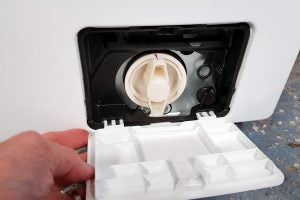
The same is true of the very quiet spin. Our tests suggest it’s a fair bit quieter than the label might have you believe. Running a full load at 1400 spin, even at its fastest, we were measuring high 60dB of noise output. Through 50% of the spin, as the speed builds, noise is in the mid-50dBs and at only the tail-end of the spin, at 1400rpm, does it get close to 70dB. That is a very, very quiet washing machine.
Samsung QuickDrive WW6800 – What programmes does it have?
The large rotary selector covers 11 main programmes, plus three rinses, spin and Drum Clean modes. Top billing goes to the maximum 8kg load Cotton Eco and Cotton programmes, with Synthetics (4kg) and Delicates (2kg) also sharing the right side of the dial. Blue LED segments light up to indicate the programme, and the approximate time pops up in the display.
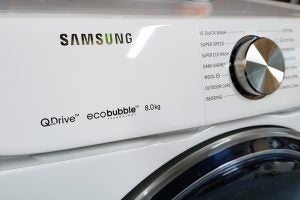
To the left of the dial (although the dial goes round and round if you keep turning clockwise) there are specialist programmes for Bedding (2kg), Outdoor Care (2kg), Wool (2kg) and Dark Garments (4kg). The Super Eco wash uses cold water and Samsung’s ecobubble technology to soak away stains in loads up to 4kg. Timings start at 1hr 10mins for this cycle, but extend out for heavily soiled loads.
If you want quicker, the Super Speed programme handles up to 5kg of daily wear garments (underwear, shirts, and so on) in just 39 minutes for a small, lightly soiled load.
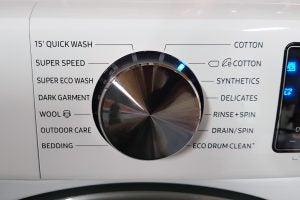
It’s still a sensor programme, so time and consumption will vary depending on load size and soiling, but it should still jingle the finish bell in under an hour. For 2kg or less of very lightly soiled garments, the 15’ Quick Wash does a light wash, rinse and spin in just 15 minutes. Be aware that you need to use less than 20g/20ml of detergent for this programme.
With the number of variables available with each programme, including Pre-Wash, Intensive, Temperature, Spin Speed, Bubble Soak and Easy Iron, you have a lot of flexibility. Things get even more innovative with Samsung’s SmartThings App. That, of course, replicates all the dashboard controls and adds a monitoring function.
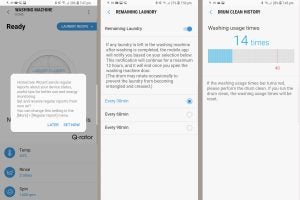
However, while every brand’s smart kitchen appliance apps can remotely control their smart washing machines, and let you know when the load is complete, the SmartThings ‘Laundry Recipe’ is a genuinely innovative smart feature. You start off by selecting the type of clothes you want to put in. Incompatible garments are greyed out, only allowing you to select items that will wash well together. Heavyweight jeans and white Arun jumpers are not great drum-fellows, for example.

You then choose the average garment colour: white, colours or dark. Then soiling level: light, normal or heavy.
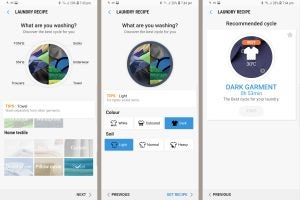
The result is the correct programme adapted to the specific wash in question. You can save any number of these Recipe programmes as favourites too. Samsung’s cartoon sheep symbol for the wool program never fails to elicit a smile when selected.

Samsung QuickDrive WW6800 – How well does it wash?
The WW6800 is a full sensor machine, meaning water and electricity use will be wholly dependent on the programme, the materials you put in, the size of the load, and how dirty it is. It isn’t an easy machine to test.
As such, we started using it for some of our regular daily washing requirements to get a feel for its abilities and running costs. We were never less than impressed.
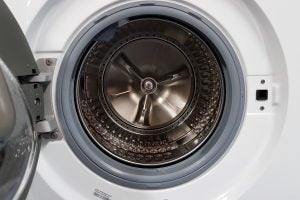
The key stain strip test – undertaken on a Cotton 40 cycle with a full 6.4kg mixed load – featured blood, coffee, turmeric, cranberry jam, ketchup and old engine oil. The six blobs were placed onto a clean cotton test strip and allowed to dry-on for 24 hours to give them some real staying power. We used a leading non-bio liquid detergent in the soap drawer. No pre-wash, no Bubble Soak, no Intensive option – just the basic Cotton wash.
The results were some of the best we’ve seen at any price. The blood, coffee, cranberry and ketchup were removed completely. The near-impossible turmeric and engine oil stains were significantly reduced. Few machines we’ve tested have dealt with the turmeric stain quite so well. And remember, this is without using any of the WW6800’s stain-busting modes such as the Bubble Soak or Intensive options.


In our daily tests from clothes that needed a light refresh to serious mucky gear from heavy gardening and strimming, the Samsung didn’t fail to disappoint. Spin efficiency, too, was very good. Throughout our tests, most loads hung onto less than 30% extra weight in water after the spin. Only the fullest, ‘stuffed-drum’ loads showed any reduction in spin performance – and, even then, the wash never held more than 34% extra weight in water. A superb result that will speed drying time on the line, or reduce drying costs in the tumble dryer.
Wash times were generally quick across the board, albeit rather dependent on load and soiling level. A full load Cotton Eco wash comes in at a promised 2hrs 15mins. That’s a good hour or two quicker than main competitors’ Cotton Eco programmes and about a week quicker than some. Yet the Samsung’s stated wash times when you first make the programme selection tend to be pretty optimistic, particularly for dirtier loads.
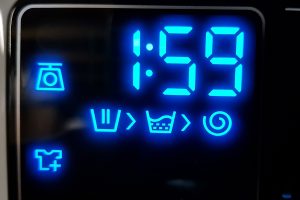
For example, it proudly stated just 1hr 4mins when you engage the standard Cotton programme at 40 degrees. Put in a full, very dirty load and the reality is well over two and half hours, with a commensurate increase in resource use. At the other end of the spectrum, put in a smaller load that only needs a light refresh and the Samsung is super-quick, sips water and uses very little electricity.
Our only note on its operation is the default to two rinses. Washed clothes on this setting emerged from the drum with a strong fragrance of the washing liquid. If you were using biological detergent and had someone in the family that was a little sensitive to it, adding a third or even fourth rinse in the options is recommended.
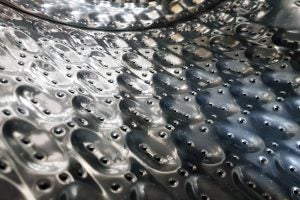
Samsung QuickDrive WW6800 – How much will it cost to run?
The Samsung’s variability of measured energy and water use depending on cycles, load size and soiling level make this a tricky calculation. It’s most frugal mode is using the Cotton Eco 40 programme and sticking with the default two rinses. Variability is much less on this programme, suggesting saving up your half loads for a full load wash is the way to go to keep running costs as low as possible.
The Cotton Eco programme used between 0.3 and 0.4kWh of electricity and just 30 litres of water to complete the wash. That’s around 5p per load in electricity and 10p in water, assuming you’ree billed at around 15p/kWh and £3.50/m supply and waste water. That’s ludicrously frugal – and running times weren’t too bad either at around two and a half hours.
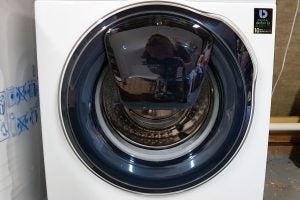
Things get a whole lot more variable when you switch to the standard programmes. Here, the WW6800 changes the cycle, electricity and water use depending on the load size, material and soiling level. On the standard Cotton 40 cycle, our best result was almost identical to the Eco programme at 36 litres of water and 0.33kWh of juice for a lightly soiled half load. That is well under 20p per load in water and electricity.
At the other end of the spectrum, a ‘stuffed to the ceiling’ drum load of gardening clothes and dozens of filthy mop heads (from steam cleaner testing) used 1kWh of electricity and 100 litres of water. That would be around 15p in electricity plus 35p of water. For near 7kg of such heavily soiled clothing, that isn’t bad at all – particularly when you consider the fantastic cleaning results.
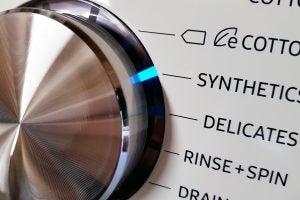
If we apply our usual 240 loads per year of normal, lightly soiled daily clothing, split 200 full loads and 40 half loads, we’d absolutely opt for the Samsung’s Cotton Eco programme every time. It’s effective, frugal and doesn’t take too long at all. Okay, if you have a really mucky household, daily mud and grass stains, then go for the excellent specialist programmes. But for low-cost daily use, its Cotton Eco all the way.
For our 240-load scenario on Cotton Eco 40, the WW6800 would use around 8200 litres of water and just 72kWh of electricity per year. Billed at 015p/kWh and £3.50 per cubic metre of water supply and waste, that would be an annual running cost of just £39.40 (£10.80 + £28.70).
Those figures are very good indeed, and only a few pounds per year behind the very best models we’ve ever tested – all of which are more expensive than the WW6800 to buy in the first place.
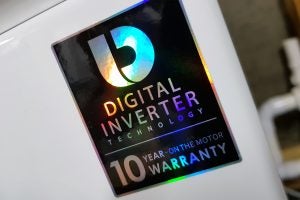
Why buy the Samsung QuickDrive WW6800?
Effective, efficient, easy to use, well featured, quick and super-quiet… do we need to say anymore?
Okay, the 8kg load capacity might look a little bijou compared to other similarly priced models, but you can at least get the full stated load into the Samsung. Cleaning results across the board were outstanding, the app is super-slick and seamless to use, and we love the Programme Recipe idea.
The WW6800 is not cheap, but it more than justifies that cost even at its full asking price, which includes a five-year guarantee (and 10 on the motor) as standard. Given that there are some great offers available on Samsung appliances if you shop around, the WW6800 sets the standard at the price.
Verdict
Great cleaning, low running costs, great features and a five-year guarantee as standard make Samsung’s WW6800 the machine to beat at the price.
Trusted Score
Key Features
| Drum Capacity | 8kg |
| Energy Rating | A+++ |
| Warranty | 5 year |
| Dimensions HxWxD (cm) | 90 x 65 x 65 cm |
| Approx. Annual Running Cost | £39.40 |
| Approx. Annual Power Consumption (KWh) | 72kWh |
| Approx. Annual Water Consumption (ltrs) | 8200l |
Standard Wash: 80% Load
| Power Consumption (KWh) | 0.4 |
| Cost Per Wash at 15p/KWh | 6p |
| Water Consumption | 30 |
| Time to Completion | 2.5hrs |
| Noise During Wash (dB) | 47 |
| Noise During Spin (dB) | 70 |
| Moisture After Spin | 32% |
Standard Wash: 40% Load
| Power Used (KWh) | 0.35 |
| Cost of Wash at 15p/KWh | 7p |
| Water Use (Litres) | 36l |
| Time to Finish | 1hr |
| Noise During Spin | 47 |
| Noise During Wash | 70 |
| Moisture After Spin (kg) | 31% |
Eco Wash: 40% Load
| Power Per Wash (KWh) | 0.32 |
| Cost Each Wash at 15p/KWh | 5p |
| Water Consumption (Litres) | 30l |
| Time to End | 2.5hrs |
| Noise (Wash Cycle) | 47 |
| Noise (Spin Cycle) | 69 |
| Moisture Post Spin (kg) | 29% |


